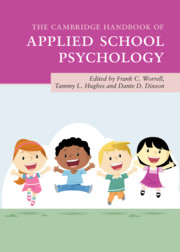Book contents
- The Cambridge Handbook of Applied School Psychology
- The Cambridge Handbook of Applied School Psychology
- Copyright page
- Contents
- Contributors
- Contributor Biographies
- Acknowledgments
- 1 Broadening the Focus of School Psychology Practice
- Part I Individual-Level Academic Interventions
- Part II Teacher- and System-Level Interventions
- Part III Interventions from Educational and Social/Personality Psychology
- 10 Belonging in Schools: A Social Psychological Perspective
- 11 Cross-Race/Ethnic Friendships in School
- 12 Self-Regulated Learning in School Contexts
- 13 School Environments that Facilitate Delaying Gratification
- 14 Understanding and Cultivating Hope in School
- 15 School Settings that Facilitate High Teacher Expectations
- 16 Parental Autonomy and Relatedness Support
- 17 Preventing and Minimizing Stereotype Threat in School Settings
- 18 The Hidden Classroom: How Gender Stereotypes Impact Academic Achievement
- Part IV Behavioral and Social-Emotional Interventions
- Part V Health and Pediatric Interventions
- Part VI Family Connections and Life Transitions
- Part VII Special Populations
- Part VIII Conclusion
- Index
- References
18 - The Hidden Classroom: How Gender Stereotypes Impact Academic Achievement
from Part III - Interventions from Educational and Social/Personality Psychology
Published online by Cambridge University Press: 18 September 2020
- The Cambridge Handbook of Applied School Psychology
- The Cambridge Handbook of Applied School Psychology
- Copyright page
- Contents
- Contributors
- Contributor Biographies
- Acknowledgments
- 1 Broadening the Focus of School Psychology Practice
- Part I Individual-Level Academic Interventions
- Part II Teacher- and System-Level Interventions
- Part III Interventions from Educational and Social/Personality Psychology
- 10 Belonging in Schools: A Social Psychological Perspective
- 11 Cross-Race/Ethnic Friendships in School
- 12 Self-Regulated Learning in School Contexts
- 13 School Environments that Facilitate Delaying Gratification
- 14 Understanding and Cultivating Hope in School
- 15 School Settings that Facilitate High Teacher Expectations
- 16 Parental Autonomy and Relatedness Support
- 17 Preventing and Minimizing Stereotype Threat in School Settings
- 18 The Hidden Classroom: How Gender Stereotypes Impact Academic Achievement
- Part IV Behavioral and Social-Emotional Interventions
- Part V Health and Pediatric Interventions
- Part VI Family Connections and Life Transitions
- Part VII Special Populations
- Part VIII Conclusion
- Index
- References
Summary
Stereotypes associating math more with men and boys than women and girls have been identified as a contributing factor to women’s underrepresentation in science, technology, engineering, and math (STEM) fields. Unfortunately, these stereotypes emerge as early as elementary school and begin to shape young girls’ math achievement and interest. This chapter documents the sources both in and outside of the school environment that contribute to the development of these stereotypes and reviews evidence for the relationship between children’s stereotypes and their math achievement. Furthermore, this chapter reviews recent research on interventions to increase young girls’ engagement in math-related fields. Strategies are provided for caregivers and educators to help change stereotypes about math and gender and disrupt the impact of these stereotypes on girls’ behavior.
- Type
- Chapter
- Information
- The Cambridge Handbook of Applied School Psychology , pp. 295 - 314Publisher: Cambridge University PressPrint publication year: 2020



